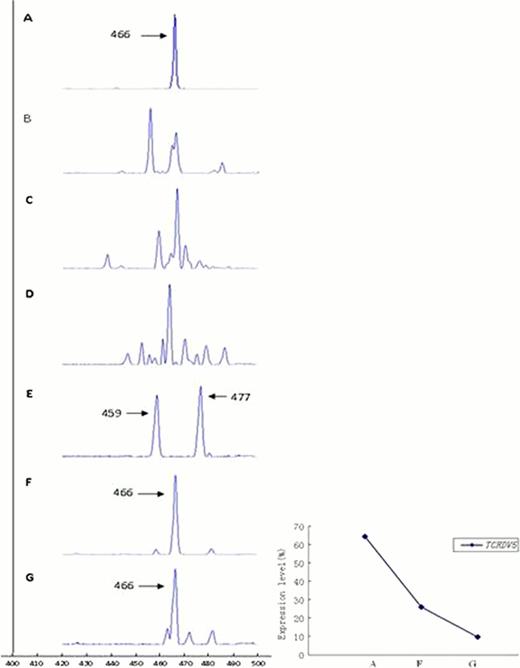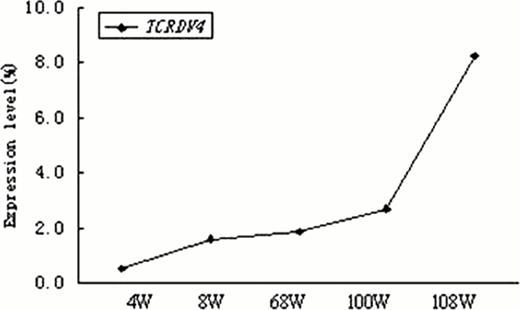Abstract
Abstract 4672
T-cell acute lymphoblastic leukemia (T-ALL) comprises 25% of adult acute lymphoblastic leukemia cases, and its outcome is poorly understood. To improve the outcome of patients with T-cell acute lymphoblastic leukemia (T-ALL), characterization of the biological features of T-ALL blast cells and the immune status of patients with T-ALL is needed to identify specific therapeutic strategies. Using a novel approach that is based on the combination of fine-tiling comparative genomic hybridization (FT-CGH) and ligation mediated PCR (LM-PCR), we molecularly identified a malignant ¦Ã¦Ä+T cell clone with a V¦Ä5D¦Ä2J¦Ä1 rearrangement that was paired with a V¦ÃI TCR and comprised a V¦Ã1V¦Ä5 T cell clone in relapse T-ALL patient. This malignant T cell clone was lost after chemotherapy, while the same malignant V¦Ä5 T cell clone revealed when disease relapse post allo-HSCT at 100 weeks (Figure 1). Using PCR and genescan analyses, the distribution and clonality of the TCRV¦Ã and TCRV¦Ä subfamilies were examined before and after allo-HSCT in a patient with T-ALL. A reactive T cell clone with a V¦Ä4D¦Ä3J¦Ä1 rearrangement was identified in all samples taken at different time points (i.e., 4, 8, 68, 100 and 108 weeks after allo-HSCT) (Figure 2). The expression of this V¦Ä4+ T cell clone was higher in the patient during complete remission post allo-SCT, and at disease relapse. In conclusion, the techniques used in this study established the sensitive detection of malignant and reactive T cell clones, and these identified T cell clones may serve not only as biomarkers for minimal residual disease detection but also as indicators for the anti-leukemia immune status in patients who achieve CR.
The clonality and size of V¦Ä5 T cells from a patient with T-ALL at different time points before and after allo-HSCT. A: T-ALL relapse before allo-HSCT. The monoclonal V¦Ä5 product size was 466 bp; B: pre-HSCT; C: 4 weeks post allo-HSCT; D: 8 weeks post allo-HSCT; E: 68 weeks post allo-HSCT. The clonal V¦Ä5 products were 459 and 477 bp. F: 100 weeks post allo-HSCT and disease relapse and G: 108 weeks post allo-HSCT and after one chemotherapy cycle. The same 466 bp monoclonal V¦Ä5 product is observed. The right figure demonstrates the expression level of the monoclonal V¦Ä5 gene at different time points.
The clonality and size of V¦Ä5 T cells from a patient with T-ALL at different time points before and after allo-HSCT. A: T-ALL relapse before allo-HSCT. The monoclonal V¦Ä5 product size was 466 bp; B: pre-HSCT; C: 4 weeks post allo-HSCT; D: 8 weeks post allo-HSCT; E: 68 weeks post allo-HSCT. The clonal V¦Ä5 products were 459 and 477 bp. F: 100 weeks post allo-HSCT and disease relapse and G: 108 weeks post allo-HSCT and after one chemotherapy cycle. The same 466 bp monoclonal V¦Ä5 product is observed. The right figure demonstrates the expression level of the monoclonal V¦Ä5 gene at different time points.
The V¦Ä4 gene expression level at different time points post allo-HSCT.
*The study was supported by grants from the National Natural Science Foundation of China (No. 30871091 and 91129720) and the Fundamental Research Funds for the Central Universities (No. 21610603 and 21612116) and the Guangdong Science & Technology Project (No. 2012B050600023).
The V¦Ä4 gene expression level at different time points post allo-HSCT.
*The study was supported by grants from the National Natural Science Foundation of China (No. 30871091 and 91129720) and the Fundamental Research Funds for the Central Universities (No. 21610603 and 21612116) and the Guangdong Science & Technology Project (No. 2012B050600023).
Chen:The study was supported by grants from the National Natural Science Foundation of China (No. 30871091 and 91129720) and the Fundamental Research Funds for the Central Universities (No. 21610603 and 21612116) and the Guangdong Science & Technology Project: Research Funding. Huang:The study was supported by grants from the National Natural Science Foundation of China (No. 30871091 and 91129720) and the Fundamental Research Funds for the Central Universities (No. 21610603 and 21612116) and the Guangdong Science & Technology Project: Research Funding. Zheng:The study was supported by grants from the National Natural Science Foundation of China (No. 30871091 and 91129720) and the Fundamental Research Funds for the Central Universities (No. 21610603 and 21612116) and the Guangdong Science & Technology Project: Research Funding. Geng:The study was supported by grants from the National Natural Science Foundation of China (No. 30871091 and 91129720) and the Fundamental Research Funds for the Central Universities (No. 21610603 and 21612116) and the Guangdong Science & Technology Project: Research Funding. Hu:The study was supported by grants from the National Natural Science Foundation of China (No. 30871091 and 91129720) and the Fundamental Research Funds for the Central Universities (No. 21610603 and 21612116) and the Guangdong Science & Technology Project: Research Funding. Zhang:The study was supported by grants from the National Natural Science Foundation of China (No. 30871091 and 91129720) and the Fundamental Research Funds for the Central Universities (No. 21610603 and 21612116) and the Guangdong Science & Technology Project: Research Funding. Yang:The study was supported by grants from the National Natural Science Foundation of China (No. 30871091 and 91129720) and the Fundamental Research Funds for the Central Universities (No. 21610603 and 21612116) and the Guangdong Science & Technology Project: Research Funding. Weng:The study was supported by grants from the National Natural Science Foundation of China (No. 30871091 and 91129720) and the Fundamental Research Funds for the Central Universities (No. 21610603 and 21612116) and the Guangdong Science & Technology Project: Research Funding. Du:The study was supported by grants from the National Natural Science Foundation of China (No. 30871091 and 91129720) and the Fundamental Research Funds for the Central Universities (No. 21610603 and 21612116) and the Guangdong Science & Technology Project: Research Funding. Li:The study was supported by grants from the National Natural Science Foundation of China (No. 30871091 and 91129720) and the Fundamental Research Funds for the Central Universities (No. 21610603 and 21612116) and the Guangdong Science & Technology Project: Research Funding.
Author notes
Asterisk with author names denotes non-ASH members.



This feature is available to Subscribers Only
Sign In or Create an Account Close Modal